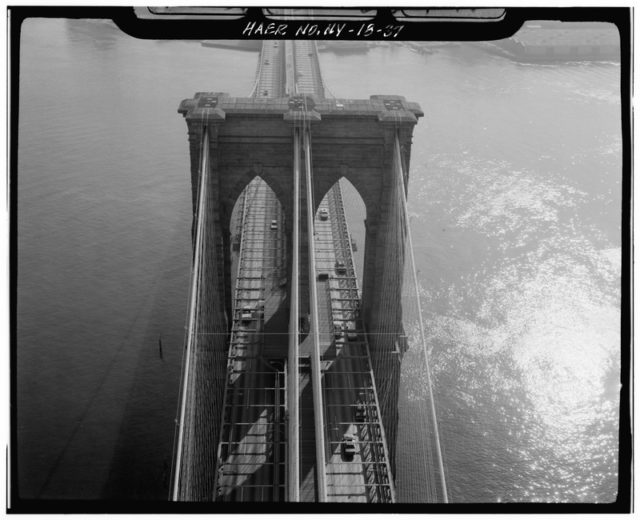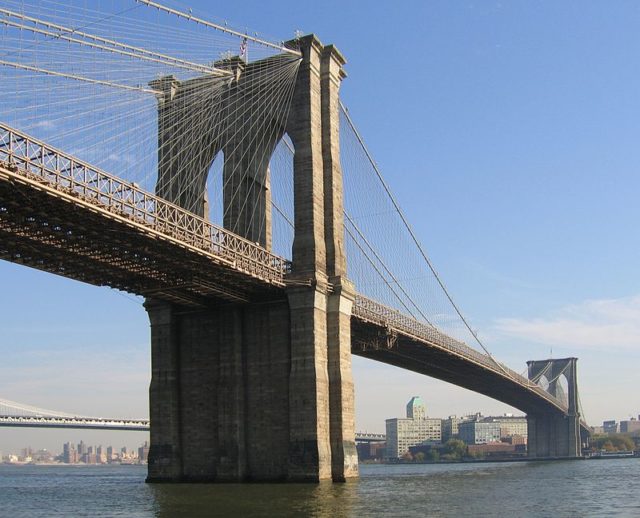Brooklyn Bridge is one of most famous bridges in the world. Spanning over the East River, it connects Manhattan with Brooklyn. The bridge was completed in 1883, becoming the first steel-wire suspension bridge ever built, and for several years, it held the record for being the longest suspension bridge in the world. With the length of 5,899 ft and the maximum height of 276.5 ft over the water, it was described as one of the seven wonders of the industrial world.
More than 20 men died during the construction of the bridge. The main designer of the bridge, John Roebling, was the first victim, followed by more workers. One week after the opening ceremony of the bridge, more than 20,000 people were on it, when a rumor that the bridge might collapse was spread among the crowd. As the panic began, 12 people lost their lives; they were crushed in the massive human stampede.

However, none of this compares to the number of people that have committed suicide by jumping off of Brooklyn Bridge. Unofficially, more than 1,300 suicides had occurred by 2003. There is speculation that every 15 days, a person dies from a fall in the East River. There were ideas of creating a suicide barrier, but the idea wasn’t realized because of engineering obstacles.
The first person ever to jump off the Brooklyn Bridge was Robert Emmet Odlum. Robert had no intention of committing suicide; he simply wanted to show that a person does not die from falling through the air.

He did this to encourage other people to jump into nets when trapped in a burning building. Besides this, he desired fame and money, which served as additional motivations for his deed. Unfortunately, he did not survive the jump.
Robert Odlum was a swimming instructor. He was born on 31 August 1851, in Ogdensburg, New York, and became a skilled swimmer at an early age. The Odlum family traveled a lot, looking for Robert’s older brother, David, who was lost in the American Civil War. Robert changed many places of residence and many professions. In 1878, he moved to Washington, where he opened a swimming school named Natatorium. The school was a huge success, and soon the children of many prominent residents of Washington became students of Odlum’s.

Odlum, who gained the nickname Professor, had among his pupils, the sons of the US President James A. Garfield, the daughter of General William Sherman, and the children of the President Rutherford Birchard Hayes. Robert had become a Washington celebrity, thanks to his many stunts, such as swimming and diving into the Potomac river, diving into the Occoquan Falls and as well, swimming from Washington to Marshall Hall, Maryland with his friend Paul Boyton, another water exhibitionist and daredevil, known as the Fearless Frogman.
In 1881, the Natatorium began losing money, so Robert decided to close the school down. He found a job as a swimming instructor at Fort Monroe at the Hygeia Hotel Hampton, Virginia, but still had the desire for fame and money.
Robert was eager to perform a jump from the newly built Brooklyn Bridge, so in 1882, he sneaked to an unfinished part of the bridge. Before he could perform the stunt, the police caught him and sent him back to Washington. Three years later, he finally succeeded in his plan.

On 19 May 1885, Robert went back to New York well prepared. The NYPD was well aware of his plans, as the story of Robert’s intentions had spread throughout the city in the weeks leading up to the event. They tightened the security on the bridge, but Odlum managed to create a distraction. He sent his friend James Haggart to the bridge in a cab while he was hiding in another car. James served as a decoy for the police, pretending that he was the jumper. While the policemen were busy with the fake jumper, Robert stepped out of the car he was hiding in. Already in his swimsuit, he jumped off the bridge at 5:35 pm, before the eyes of a witnessing crowd watching from a boat.
Robert fell in the freezing water at a speed of approximately 60 miles per hour. He hit the river surface at an angle, hitting it with his feet and hip. The disastrous outcome of the jump was caused by the strong wind blowing at the time. The lifeguard, who had been hired by Odlum himself, failed to act, so Paul Boyton jumped into the water and took Robert’s body out. After he was taken to the boat, Robert regained consciousness for a short time, asked if the jump was good, and became unconscious again. Blood started flowing from his mouth, and he died at 6:18 pm from internal hemorrhaging. The ambulance summoned by his friend did not arrive in time to save his life. The coroner stated that Robert’s liver, kidneys, and spleen were ruptured and 3 of his ribs were broken. It was concluded that concussion was the official cause of death. Robert was buried at Mount Olivet Cemetery in Washington, D.C.
After his deadly leap, Robert’s mother accused Paul Boyton of his death, claiming that he persuaded Robert to go for the jump. The Fearless Frogman denied all accountability and wrote an open letter to Mrs. Catherine Odlum which was also published in The New York Times.
In 1885, Catherine Odlum published a biographic book for her son, named “The Life and Adventures of Prof. Robert Emmet Odlum, Containing an Account of his Splendid Natatorium at the National Capital”.

One year after Robert’s death, Steve Brodie claimed to be the first man to jump off Brooklyn Bridge and survive the fall. There were no witnesses, and Brodie was accused of faking the jump by throwing a dummy from the bridge.
This alleged jump happened on 23 July 1886. One month later, Larry Donovan made the plunge into the waters of the East River, becoming the first confirmed survivor of the Brooklyn Bridge leap.
